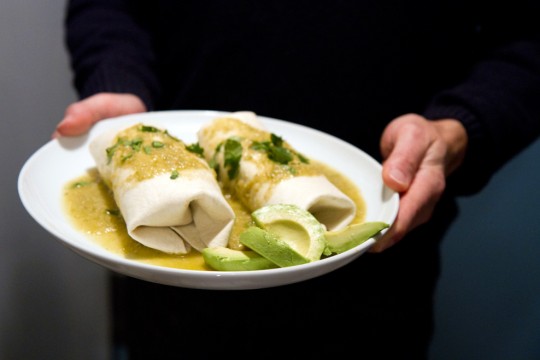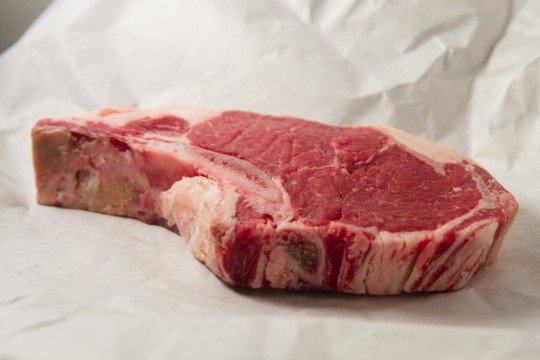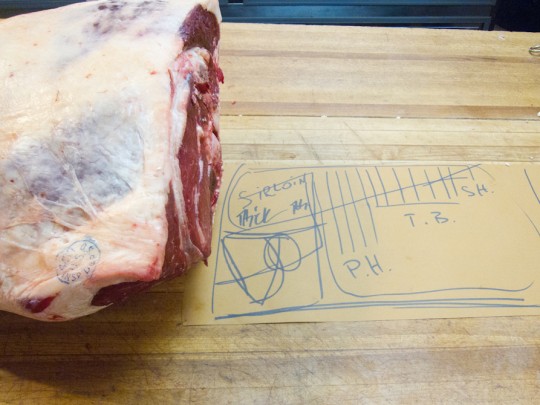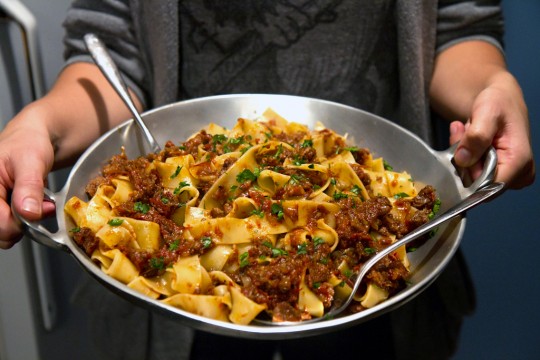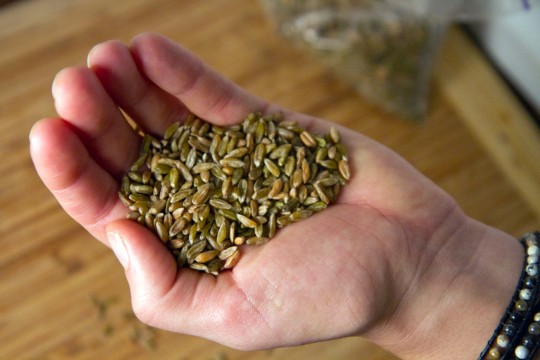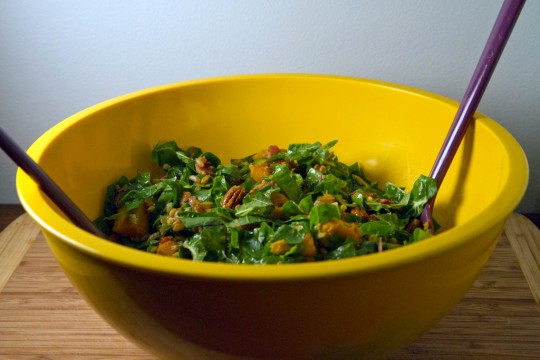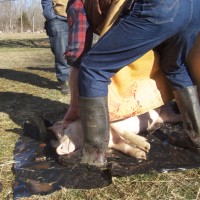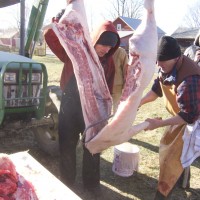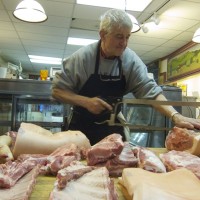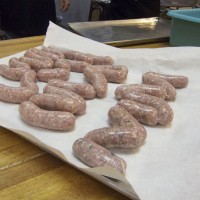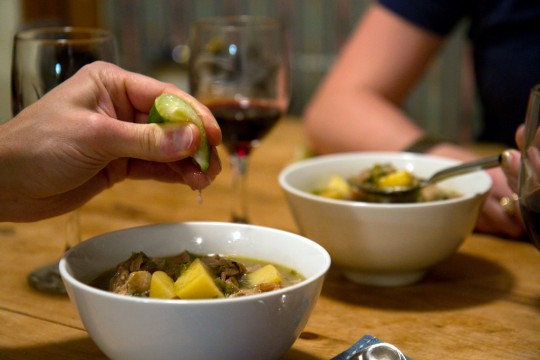
A few weeks ago Brad and I headed west to spend some time with his family in Colorado and to embark on what has now been deemed our second annual ski trip with Amanda and Alec – Amanda being Brad’s sister and Alec being her best pal, and a good friend of ours as well. Last winter the four of us spent a few days skiing in Tahoe (which was my FIRST time on the slopes) and discovered a wonderful formula: ski, cook, sleep, repeat.
My three companions grew up in Colorado and look natural as hell coming down a black diamond. Me, I took a beginner lesson last year, but have otherwise been initiated as a skiier thanks to their (very patient) teaching, encouragement and occasional forcing of me down a terrifyingly steep run. Despite our varying skill levels, we’ve found that we love hitting the mountain together.

So naturally, a few weeks in advance of our trip, once we’d sorted travel, lodging and gear, the obvious question started to circulate, “what are we going to cook?” Because really we all knew we only had one plan upon returning to the house at the end of each day: dinner together, wine included.
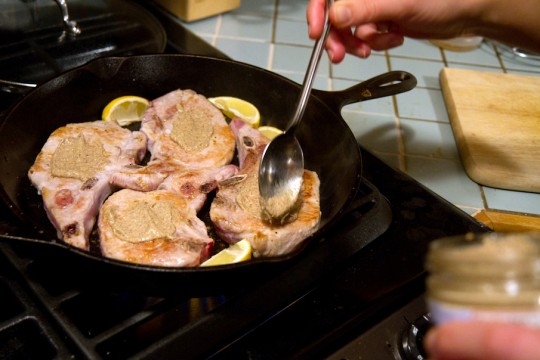
Here’s the menu that eventually took shape:
Day 1: Whole Roasted Chicken, Kale Salad, Root Vegetable Ribbons with Sage Butter
We were ravenous, even though we’d only driven that day, and it was all delicious. Kale salad is old hat and veggie ribbons were a successful trial of this recipe. Alec asked me to show him how to make stock with the leftover carcass. We all fell asleep that night and woke the next morning to the scent of simmering chicken and herbs.
Day 2: Green Chili Stew
Amanda said she’d pretty much perfected her recipe, and it was the best possible use for the stock. We left it to simmer while attending a local Mardi Gras parade and were welcomed by the aroma upon returning. All agreed the stew was tops. It was also confirmed that everything takes longer to cook at high altitude.
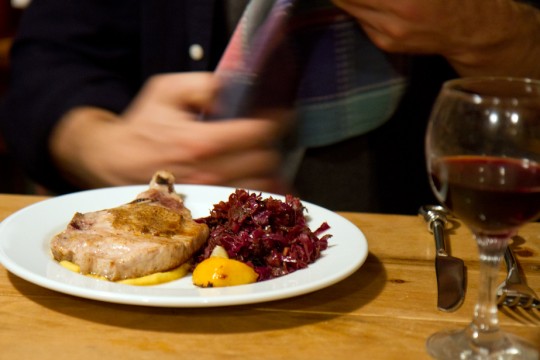
Day 3: Mustard Rubbed Pork Chops, Braised Red Cabbage, Root Vegetable Puree
In a moment of inspiration I simmered the leftover ribbons in the rest of the stock, and the resulting puree had us licking our plates. My recently mastered pan-to-oven pork chop cooking method was demonstrated, and no one could get enough of the bacon-y braised cabbage (a previous hit in all of our home kitchens).
Day 4: Braised Brisket, Roasted Sweet Potatoes and Brussel Sprouts
Braised a day in advance, my winter brisket recipe was a nostalgic redux from the previous year’s trip and voted best dish of the week. Week-long accumulation of bacon fat and a jalepeño that escaped the stew gave Alex a leg up on those roasted veggies. Not a bite of them remained.
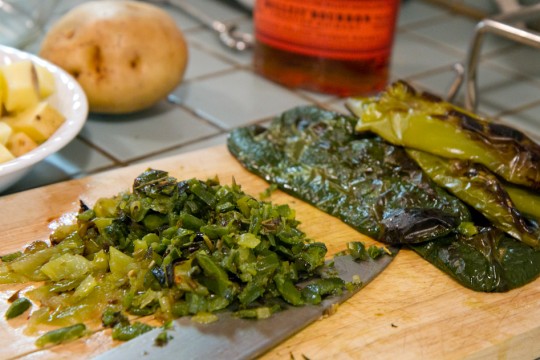
This past weekend I tested Amanda’s Green Chili Stew recipe in my Brooklyn kitchen and I concur, I think she’s nailed it. We both agree it’d be best to make this with the famous New Mexico Hatch green chiles, but having returned to our respective homes far from the Southwest, a mix of Poblanos for depth and Jalepeños for heat with whatever other green chili peppers you can get your hands on will make do without disappointment.
There were 3 men at my table when said test took place, and seconds were ravenously enjoyed. I recommend you serve the stew with some warm corn tortillas for sopping and a few wedges of lime for squeezing. You can thank Amanda when you realize this one will be in your repertoire for some time to come.
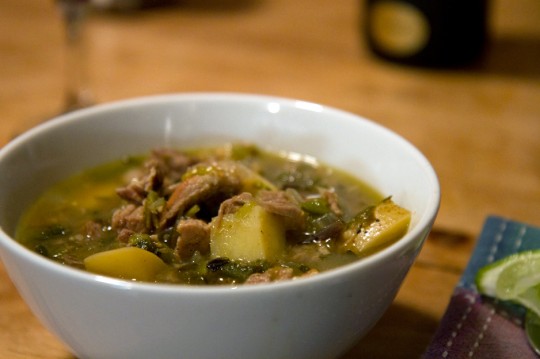
Amanda’s Green Chili Stew
Serves 6-8
- 2 1/2 – 3 lbs. boneless pork butt, cut into 2″ pieces *you want some fat included in this
- Neutral oil or bacon fat
- 4 cups stock *I used some homemade pork stock, but chicken will work just fine
- 2 lbs. mixed green chili peppers *I used 4 Poblanos, 4 Jalepeños – these are key in the mix – and a few Anaheim and Serrano peppers for good measure
- 1 lb. tomatillos, peeled and halved
- 1 large onion, chopped
- 2 cloves garlic, minced
- 2 medium potatoes, peeled and cut into 1/2″ pieces
- Water
- Salt
- Corn tortillas for serving *optional
In a dutch oven (at least 5 or 6 quarts) or heavy bottomed stock pot, heat a few tablespoons oil or fat over medium-high heat. In batches, not overcrowding, brown the pork on all sides *be sure to pat it dry first, transferring it to a plate as you brown the next batch. When the last batch is browned, add the stock to the pot, stirring and scrapping the browned bits from the bottom, along with any reserved pork. Bring to a boil and then cover and reduce to a simmer for about 2 hours.
Meanwhile, heat the oven to 350. Place the peppers in a single layer in a shallow roasting pan or rimmed baking sheet. In a second pan or oven proof skillet, place the tomatillos, cut side down. Roast, with the peppers on a lower rack and tomatillos on an upper, for about 30 minutes. Remove the tomatillos and allow to cool, then move the peppers under the broiler for about 5-7 minutes until nice and blackened in spots. Remove the peppers and allow to cool.
In a blender or food processor, puree the tomatillos and set aside. Move the peppers to a cutting board and rub the charred skins off and discard (if you’re sensitive to heat, wear gloves for handling them), remove the stems, and depending on your spice tolerance you may want to remove some or all of the seeds too*, then coarsely chop all of the peppers into roughly 1/2″ pieces. Now, wash your hands before you touch your eyes!
When the pork is ready it should be very tender. Using a fork, pull the pork apart into smaller pieces (you can also remove it to a cutting board with a slotted spoon and coarsely chop it). Transfer the pork and stock to a large bowl and reserve.
Increase the heat on the dutch oven to medium and add a about 2 tablespoons of oil or fat. Add the onions and cook, stirring occasionally until golden brown and soft. Add the potatoes and garlic and stir for a few minutes more. Add the tomatillo puree, chopped chiles, reserved pork and stock. Add a cup or so of water, if necessary, just to cover by about an inch. Bring the whole mixture to a boil and then simmer for another 30-40 minutes until the potatoes are very tender but not falling apart. Taste and season with salt if desired. Serve with warm tortillas and a wedge of lime for squeezing.
*I love me some heat, so after running it by our guests I left the seeds of all the chili peppers in and we all found it to be satisfyingly spicy. If heat isn’t your thing, simply remove the seeds and membranes from all the peppers. To take a safe, middle-of-the-road route, I’d let the Poblanos be, (Anaheims are pretty mild as well) but remove the seeds from the Jalepeños and other hot peppers.








